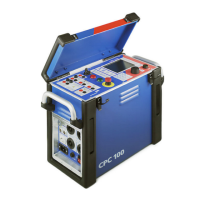CPC 100 V1.41
4 - 16
Test Settings
Figure 10:
Blank CT Excitation
test card
– Navigate to the parameter fields for "Imax:", "Vmax:" and "f:", and enter the
values according to your test requirements.
– Select check box "Auto" for automatic test (default), clear it for manual test
(refer to page 4-17).
– Set the focus onto the combo box underneath "I:".
– The options of this combo box let you determine the method for the knee
point calculation:
Once the test is finished and the knee point calculated according to the selected
method, it is possible to switch between IEC/BS, ANSI 45° and ANSI 30°. The
knee point is recalculated accordingly.
IEC/BS According to IEC 60044-1, the knee point is defined as the
point on the curve where a voltage increment of 10%
increases the current by 50%.
ANSI 45° According to IEEE C57.13, the knee point is the point
where, with a double logarithmic representation, the tangent
line to the curve forms a 45° angle.
Applies to current transformer cores without an air gap.
ANSI 30° Like ANSI 45° but forming a 30° angle.
Applies to current transformer cores with an air gap.
Note: According to the standards, the CTExcitation test card measures the
rectified mean value (rmv) of the voltage, however, during the
measurement the rms voltages are set. The rmv and rms values can
differ considerably when the CT is in saturation.

